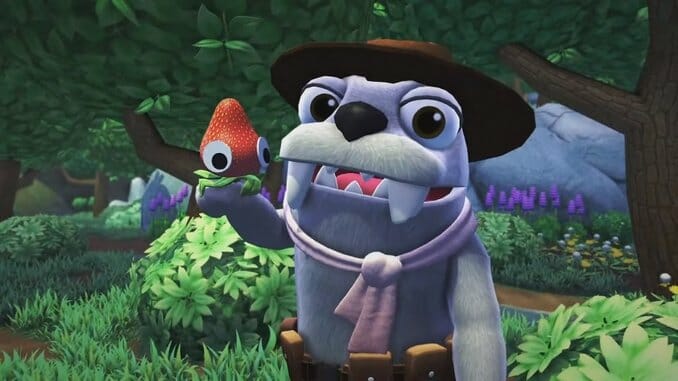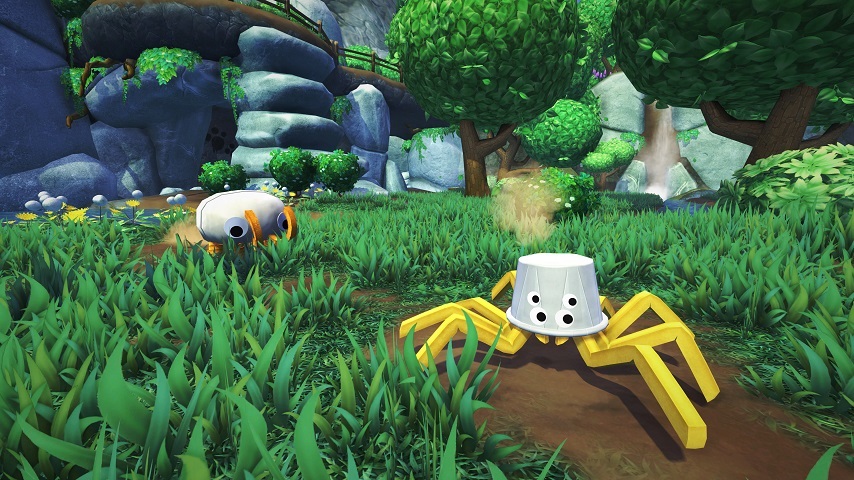
Since it was first revealed during one of the countless interminable livestreams that took the place of normal press events this year, Bugsnax had a posse. With its cute, Muppet-y character designs and that earworm of a theme song, it immediately won over almost anybody who digs games that are cute and quirky. From the start it stood out in a business that still somehow heavily revolves around grimy men with guns.
Now that Bugsnax is here, I can confirm that it’s definitely cute. For sure, it has some quirks. And it is nothing like the new Call of Duty and its irresponsible Reagan Era revisionism. It also doesn’t quite live up to the promise of that first trailer—which, to be clear, didn’t really give anybody much to go on. The problem, such that one exists, isn’t that Bugsnax is too light, too cutesy, or too silly; it’s that the game is too self-conscious about coming off as any one of those things, and thus aims for a narrative and thematic depth that it doesn’t fully embrace or justify. When Bugsnax doesn’t take itself seriously, it’s a treat; when it does, it too often leaves a bad taste.
Bugsnax is about a community of adventurers and misfits who leave society behind to settle a newly discovered island populated by creatures that are part bug, part plant, and entirely delicious. If you haven’t guessed, those creatures are called bugsnax, and they’re eaten with gusto by the cutesy colonizers known as Grumpuses. The small Grumpus village angrily split apart shortly before your arrival, with its 13 residents spreading out to every end of the island after their leader disappeared during an earthquake. The main story sees you reuniting them all back in their village, winning them over one-by-one through performing various tasks for them. Yes, the tasks all, invariably, involve bugsnax.

The Grumpuses, who look like a cross between Muppets and Ugly Dolls, all have a unique and broadly defined personality. One is an arrogant scientist who treats everybody like a test subject; another is a crass, volatile salesman who looks and talks like Danny DeVito. There’s a paranoid conspiracy theorist, a buff workout bro, a superficial gossip hound, a sturdy farmer with the voice of Sam Elliott, and a half-dozen more stereotypes that have to be rounded up over the course of the game. At times it recalls Animal Crossing, with a village full of temperamental, idiosyncratic critters with clear-cut personality types that dictate your interactions with them.
The actual play resembles another oddball Nintendo game: Pokémon Snap. There are dozens of bugsnax to be found, and like Pokémon, they’re adorable little monstrosities with names like Charmallow and Rootle, and whose entire language is made up exclusively of their own name. The common bugsnak combines a food with an insect, and has to be scanned with a camera so you can learn its patterns and weaknesses before you can capture it. You can’t grab a bugsnak with your camera; you have to use one of several different tools to capture them, from a grappling hook that will drag a stunned bugsnak to you, to a tripwire that will briefly incapacitate them. You also have a half-dozen sauces that can be used to lure them into the right spot, or drive them away, as needed.
That’s the game’s loop. You’ll meet a new Grumpus, have to trap specific bugsnax for them, and after doing that three or four times they’ll agree to move back to the village. There you’ll have to interview them (uh, you’re a journalist), and although every Grumpus will have a series of side-quests after that, that interview fulfills their role in the main storyline.
Even with bugsnax becoming increasingly tougher to catch, that repetitive loop can get a little boring. Fortunately the Grumpuses often have entertaining dialogue which can keep things moving. And although most of them wind up being fairly one-dimensional, there are a few with fears and concerns that are recognizably human. At its best Bugsnax is a surprisingly realistic and poignant depiction of depression and the toll it can take on relationships. That’s most clearly and most powerfully seen in the game’s central storyline; you’re on the island to track down the settlement’s leader, Lizbert Megafig, and her partner, the town doctor Eggabell Butternugget. (Yes, they’re all named like they’re munchkins from Wizard of Oz.) Throughout the game you’ll find filmstrips that offer glimpses of their relationship, revealing how Eggabell’s mental illness and sense of inferiority caused increasing friction between the two. These films can be uncomfortable to watch—they might hit a little too close for anybody who’s experienced similar problems in real life. Eggabell and Lizbert’s relationship gives Bugsnax a substantial emotional underpinning that helps carry much of the game’s weaker moments, but that unfortunately starts to falter near the end after some baffling story decisions.

I don’t want to give too much away, but Bugsnax’s last act takes one of the sharpest, weirdest turns of any game in recent memory, to the game’s overall detriment. When I talk about how Bugsnax turns sour when it takes itself too seriously, this is what I’m talking about. Not only does it make weird game decisions—like a climax involving multiple new tools that you wind up only using once each, with serious, lasting punishment if you don’t figure out how to properly use them quickly enough—but its final moments suddenly try to address some of the clear ethical and moral dilemmas of its premise that the game had otherwise mostly ignored. And it does so in a way that doesn’t seem to entirely understand why those dilemmas are problematic.
It’s hard to discuss the ending or its implications in full without giving at least a hint of where the game leads, so if you want to avoid all spoilers maybe skip the next two paragraphs. From the start of this game, it’s hard not to feel sympathetic for the bugsnax—they’re cute, they’re adorable, they’re mostly harmless, and even though the Grumpuses state early on that they aren’t actually animals and don’t have any thoughts or feelings, it’s still off-putting to see your character feed these bugsnax to the Grumpuses. (Yes, I’m a hypocrite: I write that despite thinking pigs and cows are adorable and still eating them regularly.) Ultimately the Grumpuses’ reliance on bugsnax destroys the entire island, and although it’s tempting to read this as a commentary on how industrial farming practices have endangered our own planet by contributing to climate change, I don’t think that’s on the game’s mind. If it was, it wouldn’t position the bugsnax as enemies to be defeated during that final climax, and the Grumpuses as friends who need to be saved. The Grumpuses came to colonize this island and devour the creatures that lived there, and in the end the game wants us to identify with them and not the bugsnax who are fighting for their own survival.
If Bugsnax wants us to seriously question our relationship to animals, our food sources, and nature itself, it probably shouldn’t turn its equivalent to our livestock into run-of-the-mill videogame bad guys who need to be killed. It shouldn’t portray these characters’ escape as success. It’d be a far bleaker and more depressing game than anybody ever would’ve expected from that first trailer if the Grumpuses wound up being punished for their hostility to nature, but if Bugsnax isn’t willing to fully engage with these weighty subjects, it shouldn’t bring them up in the first place.
Bugsnax was developed and published by Young Horses. Our review is based on the PlayStation 5 version. It is also available for PC and PlayStation 4.
Senior editor Garrett Martin writes about videogames, comedy, music, travel, theme parks, wrestling, and anything else that gets in his way. He’s on Twitter @grmartin.